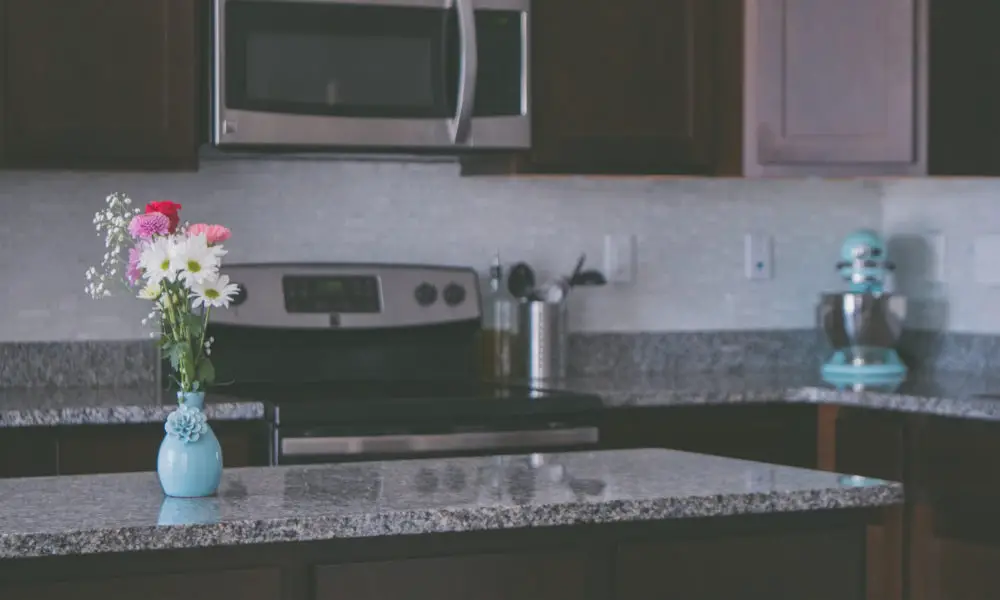Your countertop is where most of the action in the kitchen happen. Chopping, pounding, kneading, prepping, and sometimes even dining – the countertop bears the brunt of your kitchen activities. Apart from carefully planning out your kitchen layout and design, you should also take your time to decide on your kitchen countertop material.
If you’re looking at a new or refurbished kitchen, ensure you pick one that will last, as well as the right material suitable for all your kitchen antics.
Here’s all you need to know about the types of kitchen countertop materials.
1. Granite Countertops
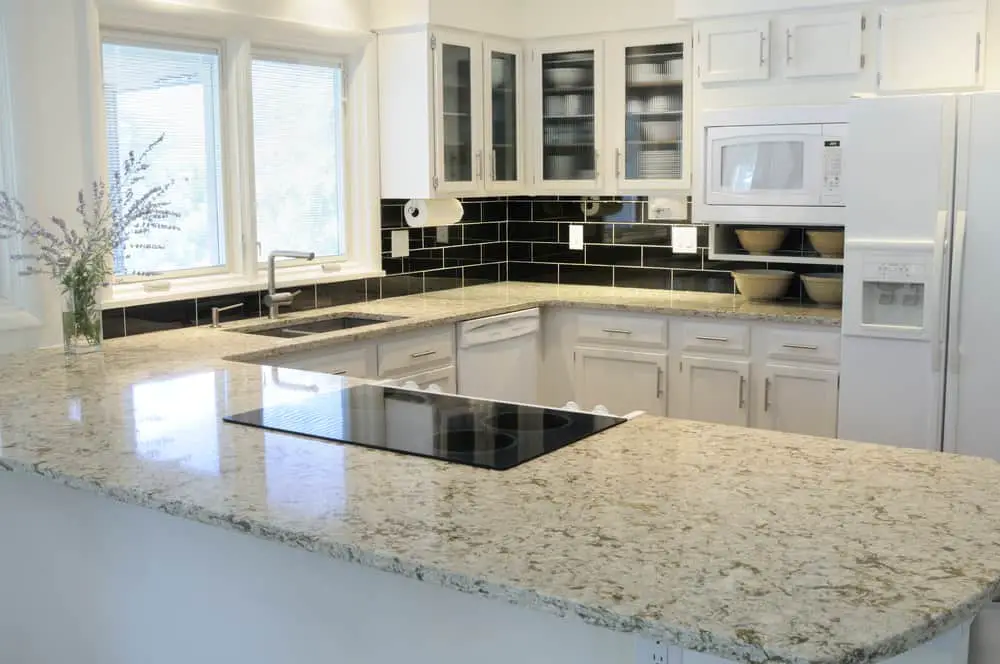
Granite countertops are natural stones sourced from large rock deposits worldwide. They are composed of a variety of minerals, which is responsible for giving each granite slab their unique and stunning vein appearances.
For the same reason, no two slabs of granite will be precisely the same. Keep this in mind, as when you decide to go with granite, make sure you buy slabs quarried from the same stone, so the colors and veining patterns are at least reasonably similar.
Granite Pros:
- It is extremely tough and durable.
- It is heat and scratch-resistant, so you don’t need to worry about knife cuts or burns from hot pots and pans.
- It’s one of the most stunning countertop materials.
- It’s low maintenance and easy to clean as long as it is sealed correctly and appropriately.
- There are over 200 different granite colors and styles to choose from.
- Granite is known to increase the real estate valuation of a home.
Granite Cons:
- It can be costly.
- It is porous, which means if it’s not appropriately sealed, liquid and other substances may seep in, which may lead to the cultivation of bacteria and staining.
- Your kitchen knife sets will not scratch your granite, but the granite can dull your knives.
- It is not suitable for DIY and can have cracks or chips if not correctly installed.
2. Marble Countertops
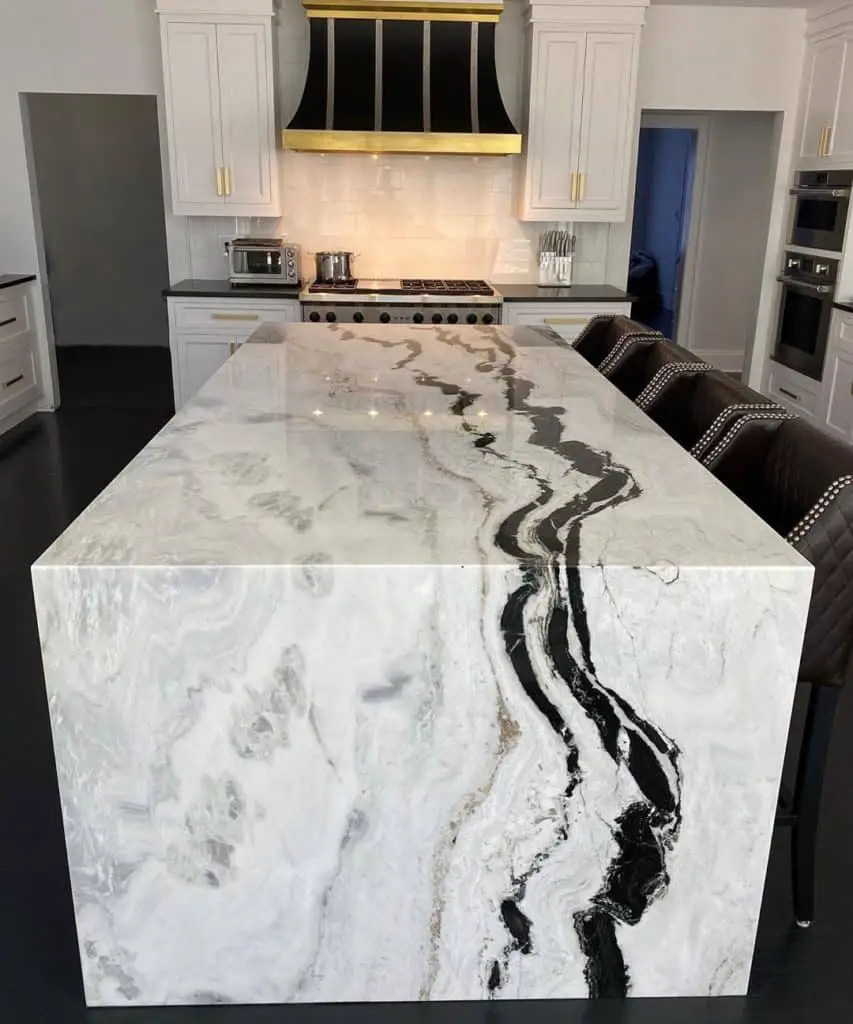
Marble is another countertop material sourced from natural stone. It contains high concentrations of minerals, which, like granite, provides its exotic veining and color. Because of its ability to turn any space look and feel elegant, marble is the material of choice for luxurious kitchens.
Marble Pros:
- The veining on the stone is so unique, no two marble slabs are similar.
- It’s incredibly stunning.
- It’s very versatile. Marble goes well with any kitchen type, from traditional to modern contemporary.
- It is waterproof and heat-resistant.
- It gets even more beautiful as it ages, developing a light patina or antique look.
- It adds to the home’s real estate valuation.
Marble Cons:
- It’s incredibly expensive.
- It is porous, requiring regular sealing.
- It also stains easily.
- It’s high maintenance – it stains easily if not cleaned meticulously.
- It is not suitable for DIY installation.
- It scratches easily compared to granite.
3. Soapstone
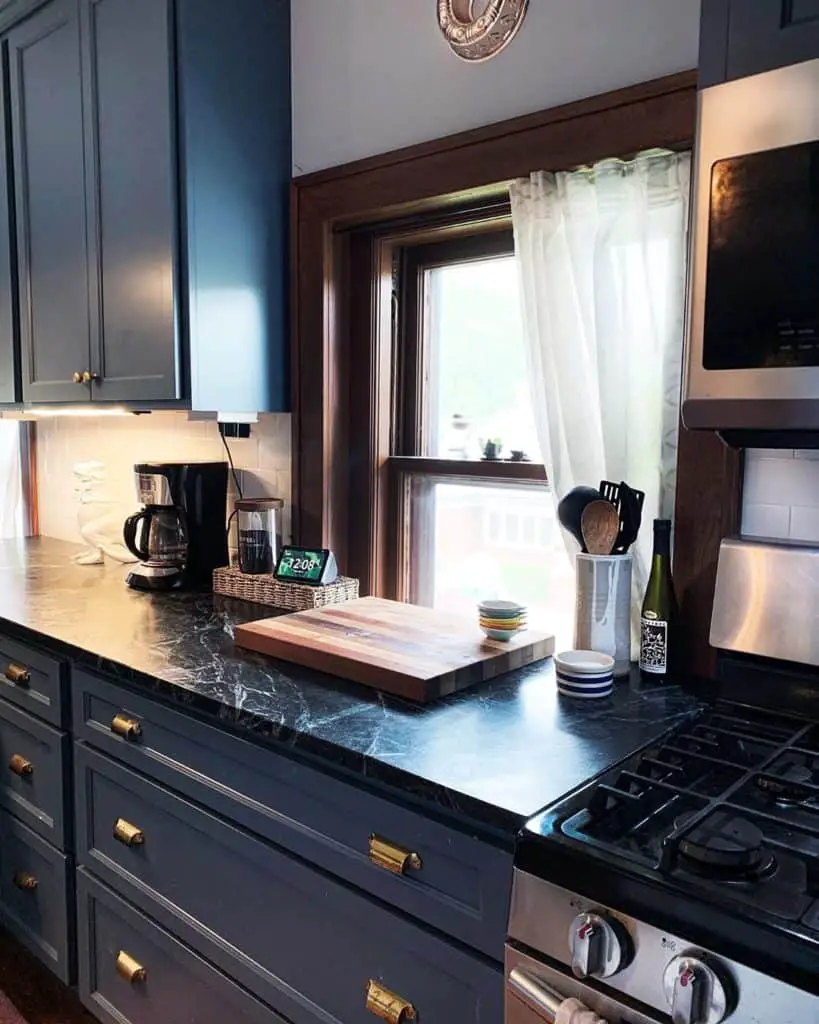
Soapstone is also a naturally-occurring stone. Like granite and marble, it contains a mix of minerals responsible for the stone’s veining. What sets this stone apart is that most contain small amounts of talc, which gives it a milky or powdery appearance and feel.
Soapstone Pros:
- It has a beautiful warmth, making it the favorite countertop material for farmhouse or country-style kitchens.
- It is pliable, so it won’t easily crack when put under stress or made to carry heavy-weighted materials.
- It’s non-porous, so you don’t need to worry about liquids seeping in. This same feature also gives the material its antibacterial property.
- It’s easy to clean.
Soapstone Cons:
- It may darken through time.
- Because it is pliable, it is prone to scratches and dents.
- It is not suitable for DIY installations.
4. Quartz Countertops
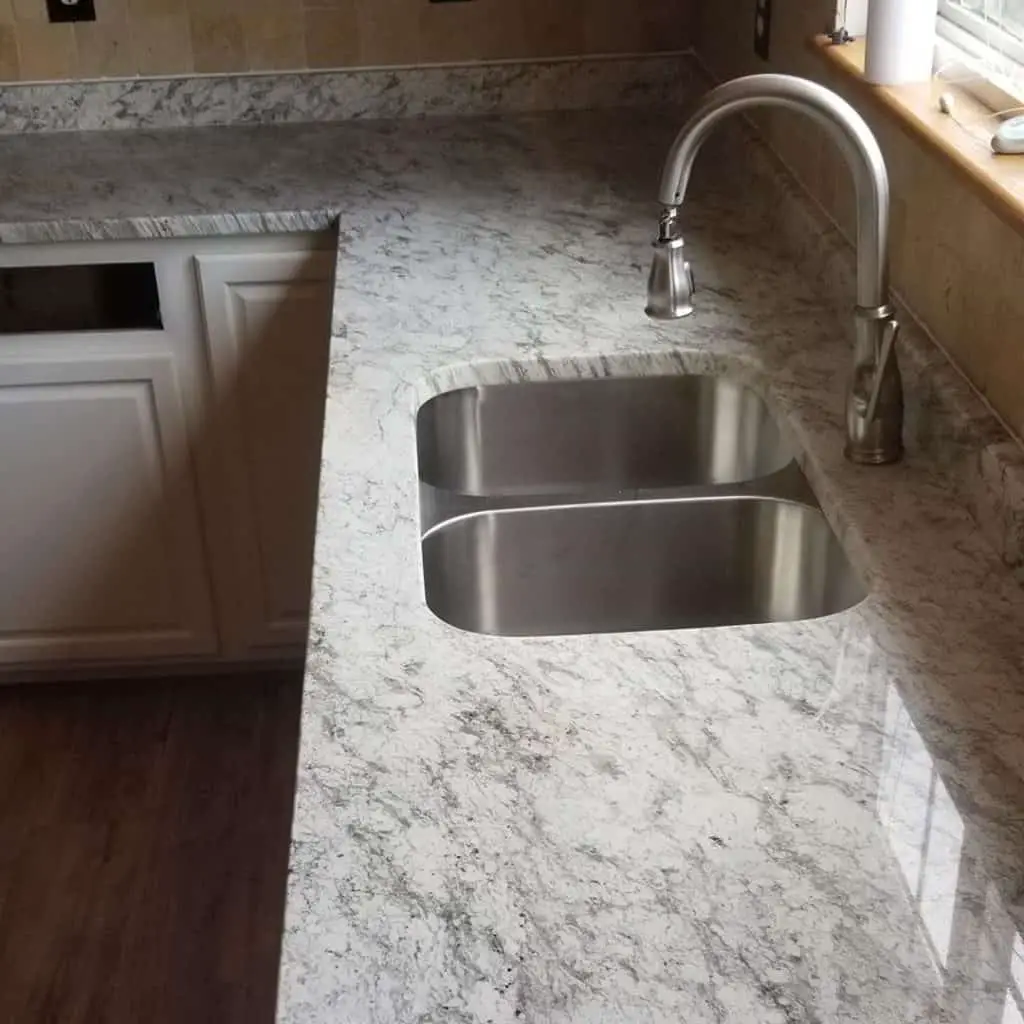
Quartz is an engineered stone. It is created by combining ground quartz (which is a natural material) and a polyester resin binder. Various pigments are added for color, and recycled glass particles or metallic flakes are mixed in for added design and reflectivity.
Quartz Pros:
- Quartz is suitable for DIY installation.
- It’s easy to maintain without the need for sealing.
- Because it is engineered, the slabs have uniform colors and veining.
- It comes in a great range of patterns, colors, finishes, and textures.
- It is non-porous, so it is stain resistant and is antibacterial.
- It’s sturdy and scratch-resistant.
- It is very durable.
- It can be custom cut your size and shape preferences.
Quartz Cons:
- It’s among the most expensive countertop materials.
- Prolonged direct sun exposure can lead to fading and cracking over time.
- It is not as heat resistant compared to other materials, such as granite or concrete.
5. Concrete Countertops
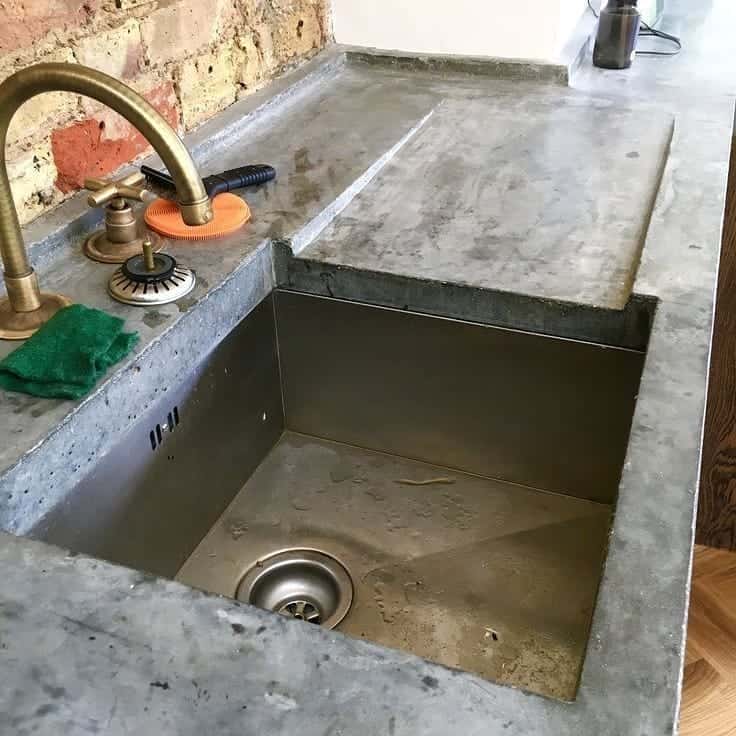
Concrete countertops are among the newest kitchen countertop materials. Unlike other materials that come in slabs, concrete is usually custom-made. Although some are produced off-site, concrete is typically mixed, framed, and poured directly into your kitchens.
Concrete Pros:
- It is incredibly strong, durable, and does not chip easily.
- Because it can be custom-made, it is the perfect material for oddly-shaped and sized kitchen spaces.
- It can also be textured or embellished.
- It is heat and scratch proof.
Concrete Cons:
- DIY installation is not possible.
- Due to its customization, it can incur higher costs.
- It is porous, requiring regular sealing.
- It may crack over time.
6. Laminate Countertops
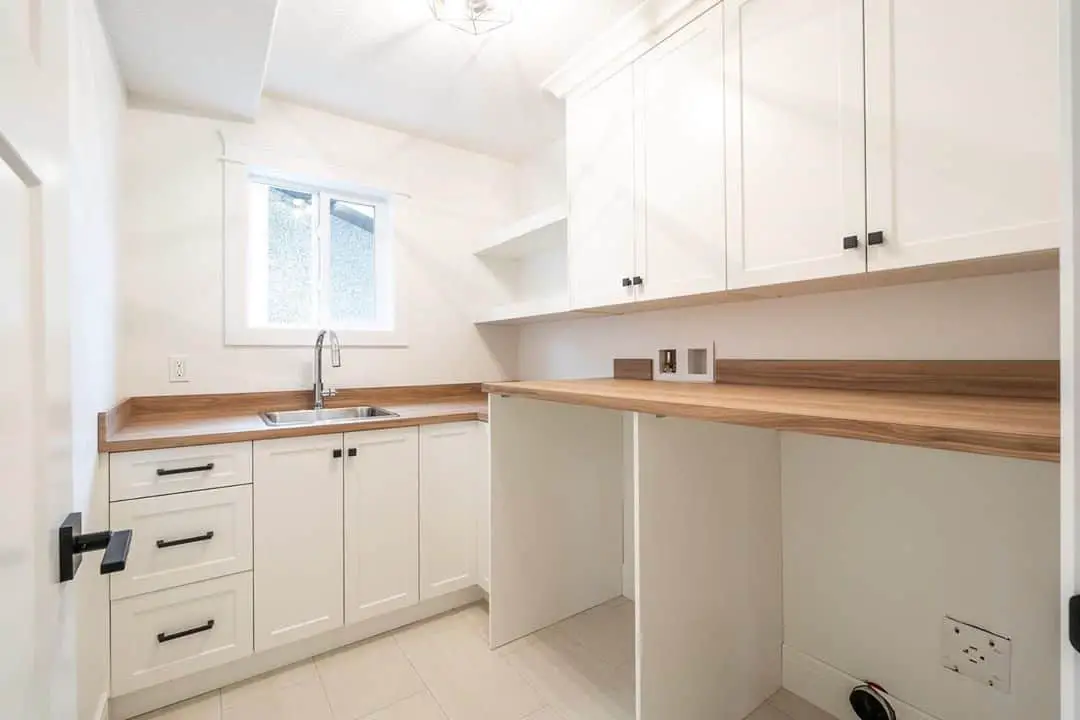
Laminate countertops are made of a firm particle board base covered with layers upon layers of plastic laminate. They can be purchased as already formed segments, or can also be custom-fabricated according to the homeowner’s specifications.
Laminates are increasing in popularity because of their affordability and the number of colors and styles available. They are particularly popular in retro or mid-century modern kitchen designs.
Laminate Pros:
- It is inexpensive.
- There are over thousands of color palettes and hundreds of styles and texture available.
- It is DIY friendly.
- It is low maintenance and one of the easiest countertop material to clean.
- It is a solid, non-porous surface, so liquid cannot easily seep in.
Laminate Cons:
- It is easily scratched, so best to keep your kitchen knife sets away from your laminate surfaces.
- It is not heat resistant.
- Once damaged, it is challenging to repair, so you may end up replacing it altogether.
7. Tile Countertops
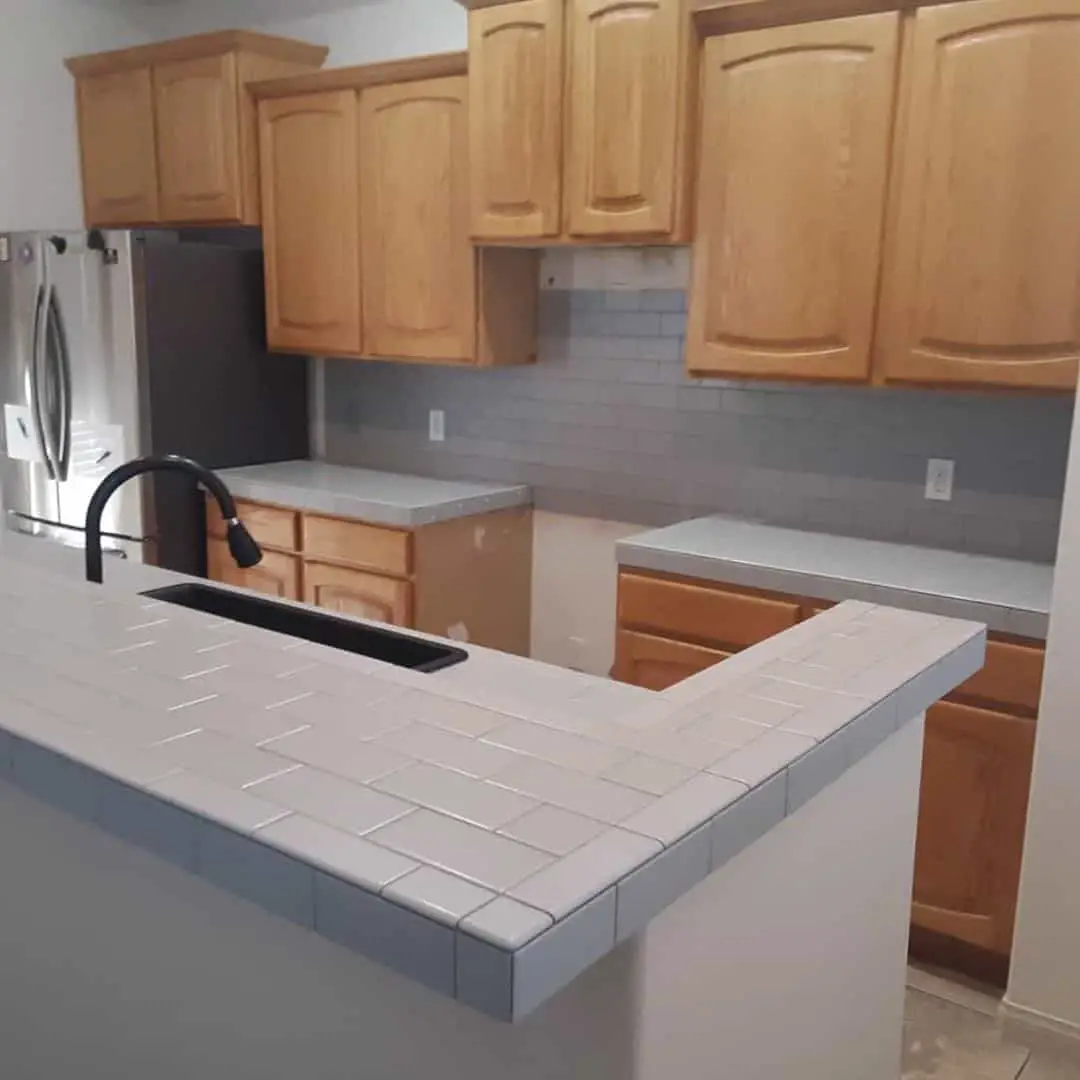
Tile countertops can be made from ceramic, porcelain, or glass tiles. The most popular choice for kitchen countertops is ceramic tiles, because of its affordability and versatility. Not only are tiles great for countertops, but they are also favorites for kitchen backsplash materials. Some tile patterns are used to create feature walls, spanning from the counter through to the range hood.
Tile Countertop Pros:
- Your design and color options are limitless.
- Because tile comes in a variety of sizes and shapes, it’s the perfect choice for covering even the most awkward spaces in your kitchen.
- It goes with any kitchen style.
- It is durable and can last for more than 50 years if cared for properly.
- The tiles themselves are incredibly easy to clean.
- It is heat resistant.
- Standard tiles are relatively affordable.
Tile Countertop Cons:
- Custom tiles may be expensive.
- It is brittle, easily cracking with impact.
- The grout between the tiles is prone to staining and can be extremely difficult to clean.
- Although standard tiles may be inexpensive, the labor costs of installing them can be expensive or if labor-intensive if you’re doing it yourself.
8. Solid Surface Countertops
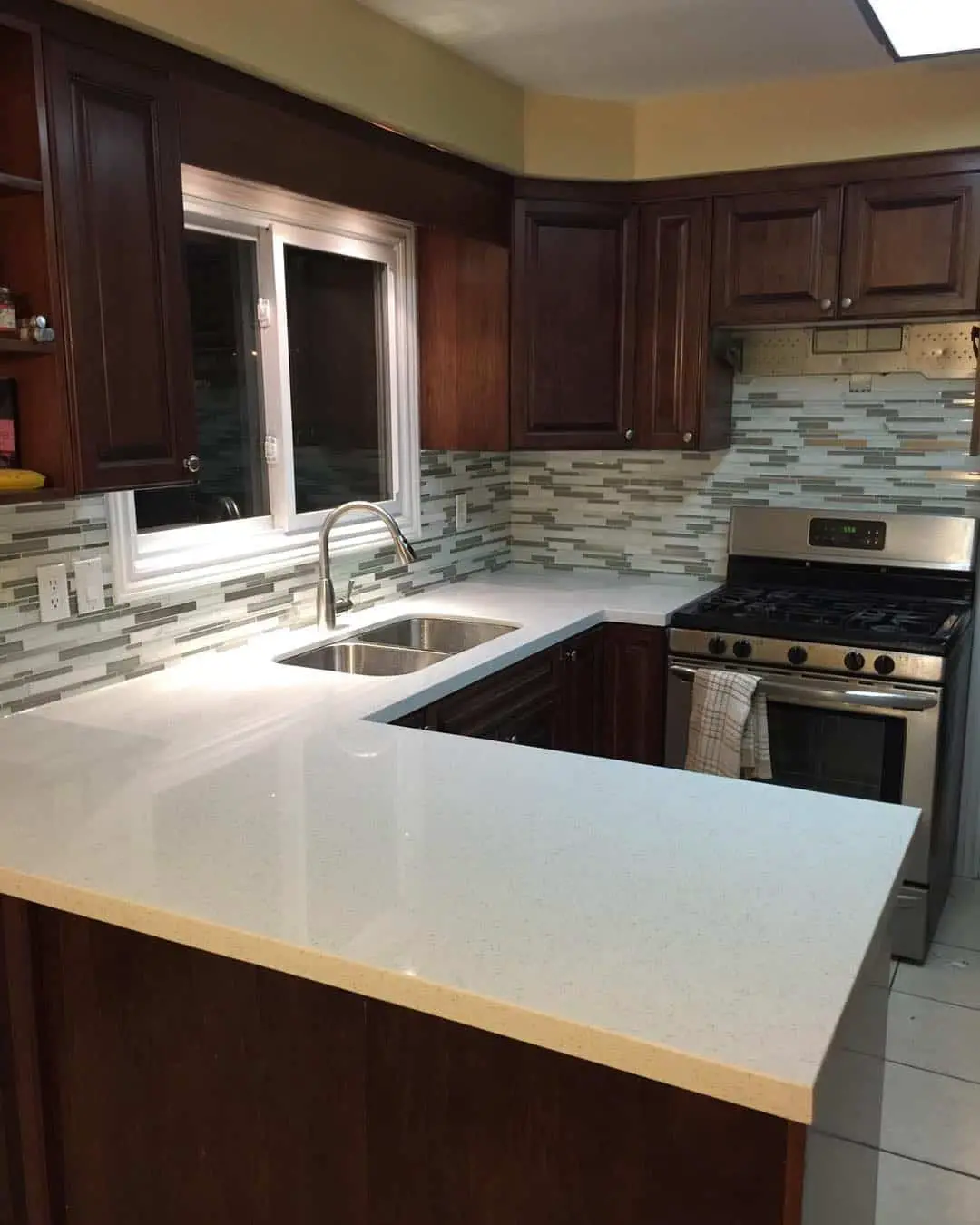
Solid surface countertops are among the newest forms of kitchen countertop material. They are composed of synthetic material containing acrylics and resins compressed into sheets and shapes.
Solid surface countertops are popular alternatives to laminates because they are believed to be better in quality and have lesser disadvantages than laminates.
Solid Surface Countertop Pros:
- It is hard and durable.
- It is stain-resistant.
- It has a seamless appearance even after installation.
- It is available in so many colors and patterns. It can even be made to resemble some granite, quartz, or marble patterns. The same versatility makes it suitable for any kitchen design, from classic to contemporary.
- Damage can be sanded out.
- Integrated kitchen sink units are possible with this type of material.
- It is low-maintenance and one of the easier countertop materials to clean.
- It is non-porous.
Solid Surface Countertop Cons:
- It is not as heat resistant compared to quartz or natural stone countertops, so they are vulnerable to heat damage from pots and pans.
- It is on the more expensive end of the price spectrum.
- DIY is not possible and requires the installation of professionals, which may incur more costs.
9. Stainless Steel Countertops
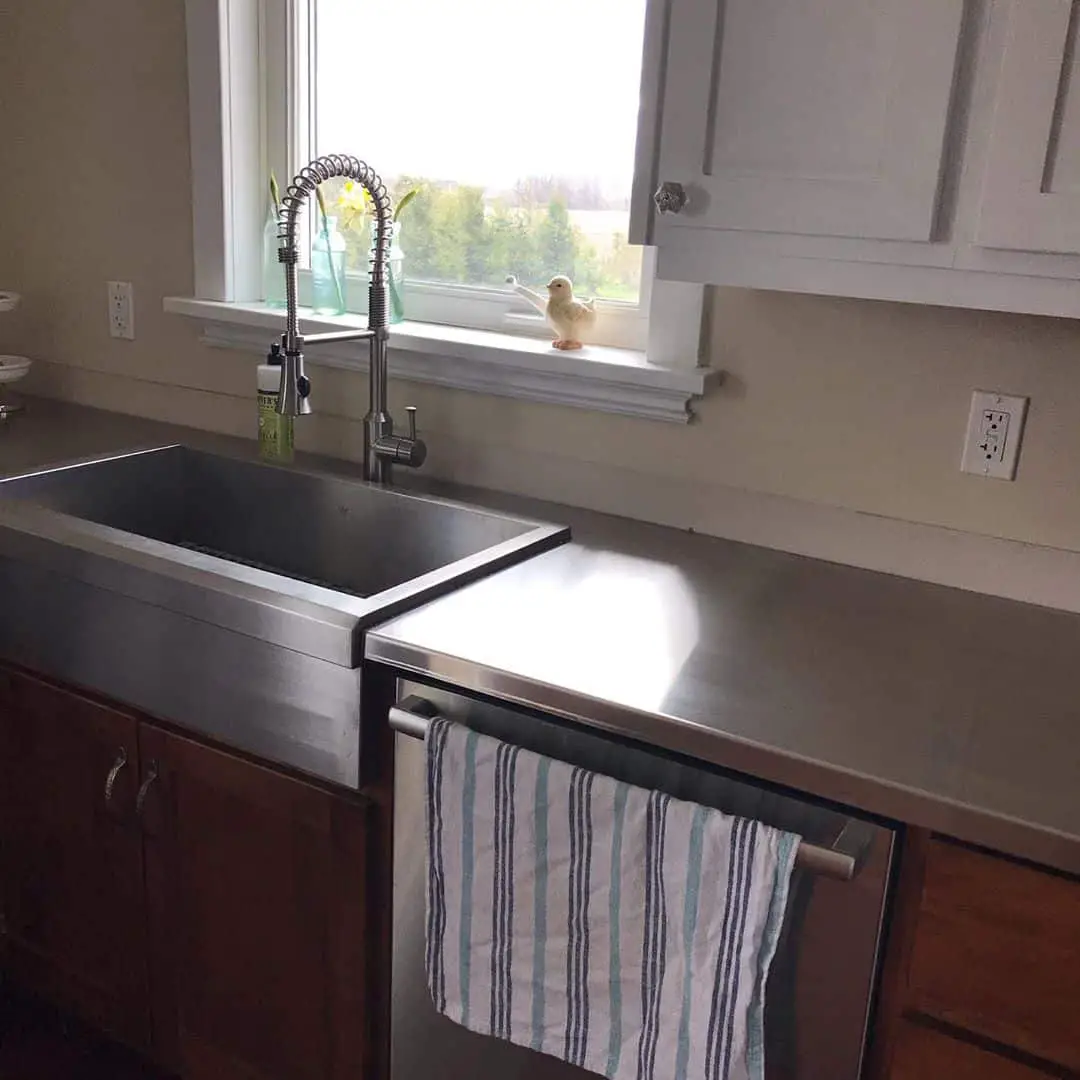
Since the introduction of stainless steel kitchen sinks in the early 1940s, stainless steel as a kitchen surface material from backsplashes to countertops has become a popular option for both functionality and aesthetics.
A lot of modern kitchen appliances are made of stainless steel finishes. Because of this, stainless steel has become a popular choice for kitchen countertop material, especially in modern kitchens, to maintain a cohesive, seamless, reflective look.
Other than modern kitchens, stainless steel countertops are also ideal for industrial and contemporary style kitchens.
Stainless Steel Pros
- It is the easiest kitchen countertop material to clean.
- It is thought to be a premium countertop material, which adds to your home’s real estate valuation.
- It’s simple yet beautiful. It can complement the rest of your kitchen’s design elements, whether it be wooden cabinetry or flooring. It also goes well with natural stone floors.
- It is durable and can last long.
- It is non-porous, making it impossible for liquids or other substances to get into the rest of your cabinetry.
- Also, because it is non-porous, bacteria don’t collect within. This antibacterial feature is one of the reasons stainless steel is the main material of choice for commercial kitchens.
- It is stain-resistant.
Stainless Steel Cons:
- The excellent quality (thicker) stainless-steel material is expensive.
- It is very prone to scratches, so it is not suitable as a cutting surface. It is best to use a chopping board when cutting things with your kitchen knife sets.
10. Wood Countertops
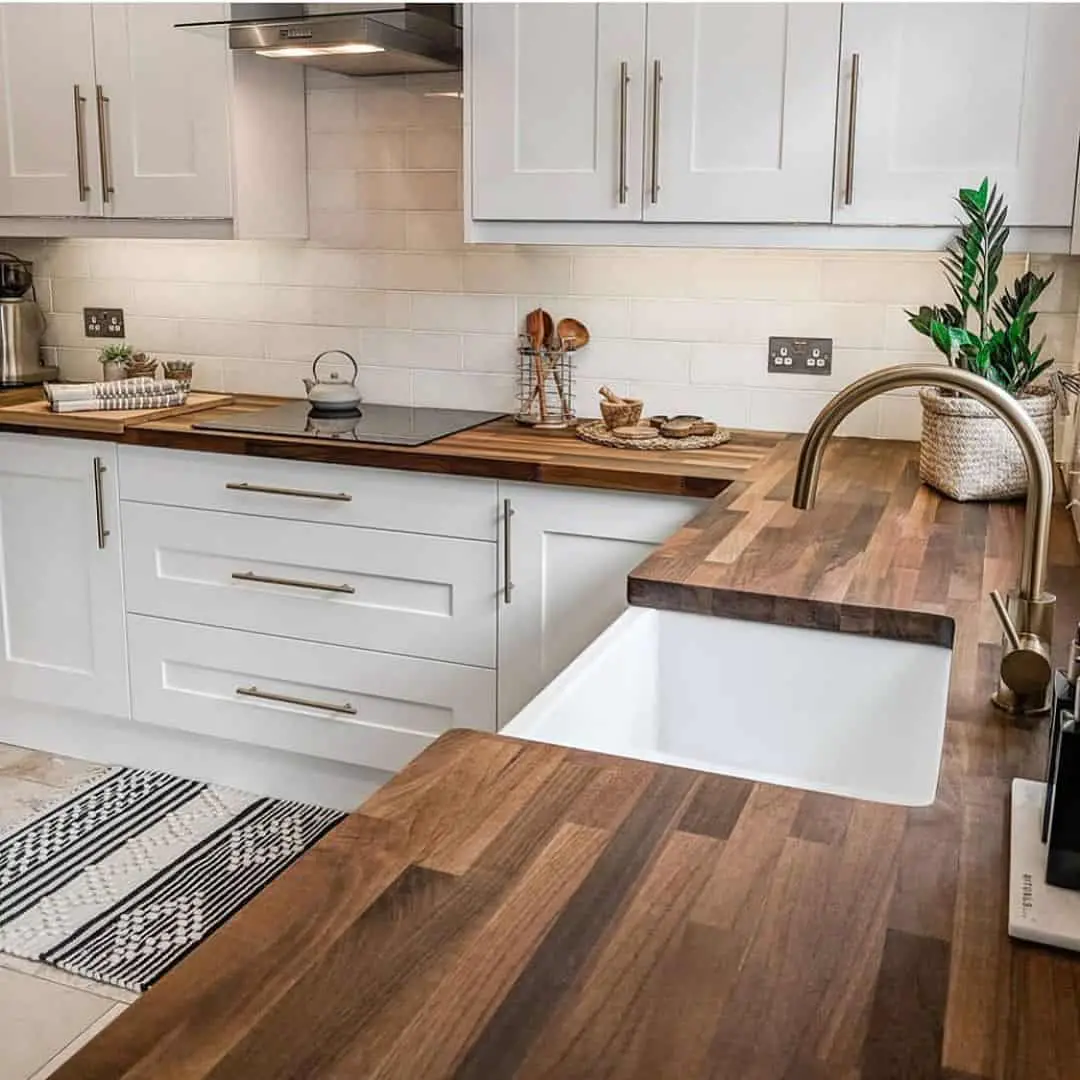
Wood countertops are among the classic kitchen countertop choices. Wood countertops come in a variety of textures, shades, and finishes. A lot of homeowners love wood, as it gives off a warm, inviting, and friendly feel. The most popular wood species used in kitchen countertops are maple and hardwood. Wood can be affordable or extremely expensive, depending on the wood species used.
Wood Countertop Pros:
- When properly cared for, wood can last for astonishingly long periods.
- It is relatively low maintenance and easy to clean.
- Wood’s natural warmth and beauty, regardless of its species, make it an attractive choice for any type of kitchen design.
- It handles and hides cuts well, so you don’t have to worry about keeping your kitchen shears or kitchen knife sets away from this type of countertop.
- It goes well with almost any cabinetry style, color, and material.
Wood Countertop Cons:
- Continued water exposure can damage the wood over time. Because of this, it’s probably a good idea to keep wood countertops away from your kitchen sinks or seal them properly to avoid water seeping through.
- It is high maintenance. If not sealed and oiled periodically, wood has the tendency to crack. Inadequate sealing can also lead to bacterial problems.
11. Recycled Glass Countertops
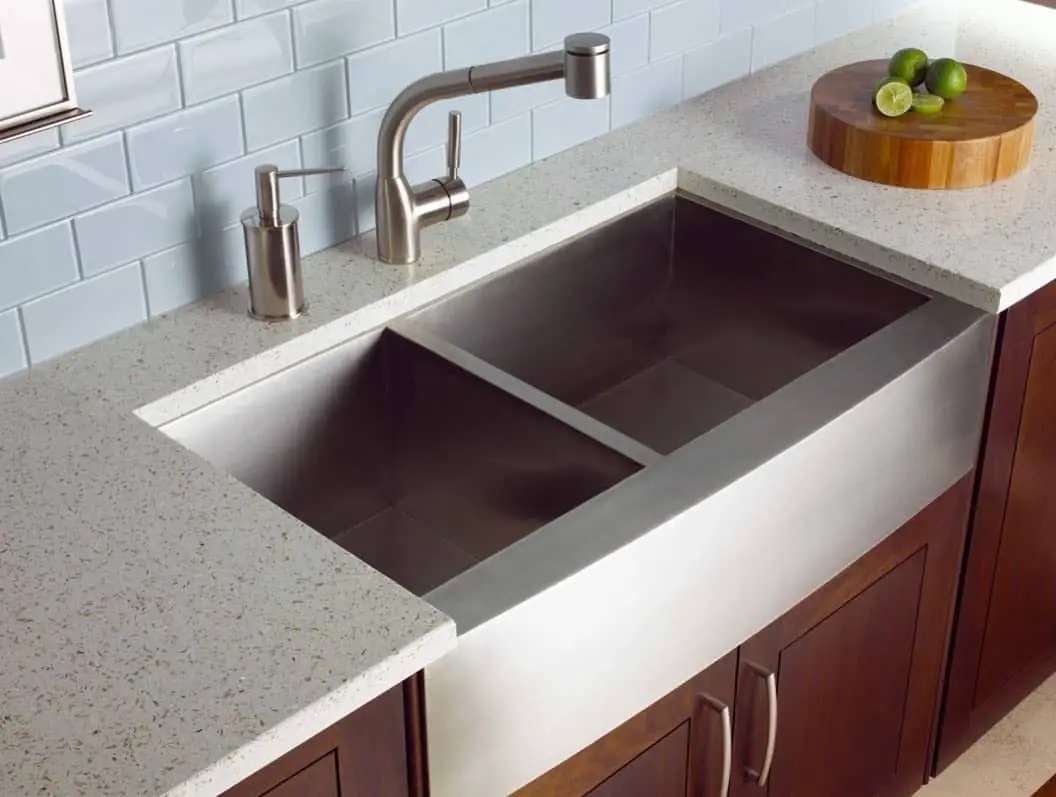
Recycled glass countertops started coming into production sometime from 1995. The glass used to create this material comes from a combination of domestic and commercial sources. The recycled glass material is held together by a cement binder. This type of countertop comes in a variety of styles and color schemes. Because of its recycled nature, it is becoming an increasingly popular choice for eco-conscious homeowners.
Recycled Glass Pros:
- It is eco-friendly.
- It is durable and robust, and are not easily cracked nor chipped.
- It is heat and stain-resistant.
- It is non-porous, making it hygienic and easier to clean and maintain.
- Because it is made of recycled glass, each recycled glass unit is unique.
Recycled Glass Cons:
- It is not suitable for DIY as if incorrectly installed, they can crack on certain stress points.
- Some recycled glass units show visible signs of fingerprints or water spots.
- Some recyclable countertop materials can be expensive.
Summary
Choose your kitchen countertop material with careful consideration. Go for the material that suits the level of activity you do in the kitchen.
With a good range of kitchen countertop materials available, it is always possible to find one that works for you in terms of both functionality and beauty.
